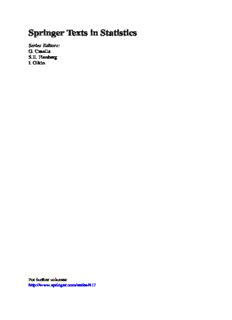
Linear Mixed-Effects Models Using R: A Step-by-Step Approach PDF
Preview Linear Mixed-Effects Models Using R: A Step-by-Step Approach
Springer Texts in Statistics SeriesEditors: G.Casella S.E.Fienberg I.Olkin Forfurthervolumes: http://www.springer.com/series/417 Andrzej Gałecki (cid:129) Tomasz Burzykowski Linear Mixed-Effects Models Using R A Step-by-Step Approach 123 AndrzejGałecki TomaszBurzykowski UniversityofMichigan CenterforStatistics 300NorthIngallsBuilding HasseltUniversity AnnArbor AgoralaanD Michigan Diepenbeek USA Belgium ISSN1431-875X ISBN978-1-4614-3899-1 ISBN978-1-4614-3900-4(eBook) DOI10.1007/978-1-4614-3900-4 SpringerNewYorkHeidelbergDordrechtLondon LibraryofCongressControlNumber:2012941857 ©SpringerScience+BusinessMediaNewYork2013 Thisworkissubjecttocopyright.AllrightsarereservedbythePublisher,whetherthewholeorpartof thematerialisconcerned,specificallytherightsoftranslation,reprinting,reuseofillustrations,recitation, broadcasting,reproductiononmicrofilmsorinanyotherphysicalway,andtransmissionorinformation storageandretrieval,electronicadaptation,computersoftware,orbysimilarordissimilarmethodology nowknownorhereafterdeveloped.Exemptedfromthislegalreservationarebriefexcerptsinconnection with reviews or scholarly analysis or material supplied specifically for the purpose of being entered and executed on a computer system, for exclusive use by the purchaser of the work. Duplication of this publication or parts thereof is permitted only under the provisions of the Copyright Law of the Publisher’slocation,initscurrentversion,andpermissionforusemustalwaysbeobtainedfromSpringer. PermissionsforusemaybeobtainedthroughRightsLinkattheCopyrightClearanceCenter.Violations areliabletoprosecutionundertherespectiveCopyrightLaw. Theuseofgeneraldescriptivenames,registerednames,trademarks,servicemarks,etc.inthispublication doesnotimply,evenintheabsenceofaspecificstatement,thatsuchnamesareexemptfromtherelevant protectivelawsandregulationsandthereforefreeforgeneraluse. While the advice and information in this book are believed to be true and accurate at the date of publication,neithertheauthorsnortheeditorsnorthepublishercanacceptanylegalresponsibilityfor anyerrorsoromissionsthatmaybemade.Thepublishermakesnowarranty,expressorimplied,with respecttothematerialcontainedherein. Printedonacid-freepaper SpringerispartofSpringerScience+BusinessMedia(www.springer.com) Bliskimmojemu sercu Olii Łukaszowi Rodziniei Nauczycielom Dekadentom –A.T.G. Moimnajbliz˙szymi przyjaciołom –T.B. In memoryofTom Ten Have Preface Linear mixed-effects models (LMMs) are powerful modeling tools that allow for the analysis of datasets with complex, hierarchical structures. Intensive research during the past decade has led to a better understanding of their properties. The growing body of literature, including recent monographs, has considerably increased their popularity among applied researchers. There are several statistical softwarepackagescontainingroutinesforLMMs.Theseinclude,forinstance,SAS, SPSS,STATA,S+,andR.ThemajoradvantageofRisthatitisafreelyavailable, dynamically developing, open-source environment for statistical computing and graphics. The goal of our book is to provide a description of tools available for fitting LMMsinR.Thedescriptionisaccompaniedbyapresentationofthemostimportant theoreticalconceptsofLMMs.Additionally,examplesofapplicationsfromvarious researchareasillustratethemainfeaturesofboththeoryandsoftware.Thepresented materialshouldallowreaderstoobtainabasicunderstandingofLMMsandtoapply them in practice. In particular, we elected to present several theoretical concepts and their practical implementation in R in the context of simpler, more familiar classes of models such as e.g., the classical linear regression model. Based on theseconcepts,moreadvancedclassesofmodels,suchasmodelswithheterogenous varianceandcorrelatedresidualerrors,alongwithrelatedconceptsareintroduced. Inthisway,weincrementallysetthestageforLMMs,sothattheexpositionofthe theory and R tools for these models becomes simpler and clearer. This structure naturally corresponds to the object-oriented programming concept, according to which R functions/methods for simpler models are also applicable to the more complexones. We assume that readers are familiar with intermediate linear algebra, calculus, andthebasictheoryofstatisticalinferenceandlinearmodeling.Thus,theintended audiencefor this book is graduatestudents of statistics and appliedresearchersin otherfields. Ourexpositionofthetheoryofvariousclassesofmodelspresentedinthebook focusesonconcepts,whichareimplementedinthefunctionsavailableinR.Readers vii viii Preface interested in a more detailed description of the theory are referred to appropriate theoreticalmonographbooks,whichweindicateinthetext. There are a large number of R packagesthat can be used to fit LMMs. Rather thanattemptingtodescribeallofthesepackages,wefocusmainlyontwoofthem, namely,nlme andlme4.0.Inthisway,we canprovidea moredetailedaccountof thetoolsofferedbythetwopackages,whichincludeawidevarietyoffunctionsfor modelfitting,diagnostics,inference,etc. The package nlme includes functions, which allow fitting of a wide range of linear models and LMMs. Moreover,it has been available for many years and its codehasbeenstableforsometimenow.Thus,itisawell-establishedRtool. In turn, lme4.0 is a developmental branch version of the lme4 package. The latterhasbeenunderdevelopmentforseveralyears.Bothpackagesofferanefficient computational implementation and an enhanced syntax, though at the cost of a more restricted choice of LMMs, as compared to the nlme package. At the time ofwritingofourbook,theimplementationofLMMsinlme4hasundergonemajor changesintermsofinternalrepresentationoftheobjectsrepresentingfittedmodels. Consequently,atthebeginningof2012,asnapshotversionoflme4hasbeenmade availabletotheRusersunderthenameoflme4.0.Asweanticipatethatlme4.0will notundergoanymajorchanges,wedecidedtopresentitinmoredetailinourbook. Wewouldliketounderscore,however,thatthemajorpartofthesyntax,presented inthebook,willbeapplicablebothtolme4andlme4.0. Allclassesoflinearmodelspresentedinthebookareillustratedusingdatafroma particulardataset.Inthisway,thedifferencesbetweenthevariousclassesofmodels, aswellasdifferencesintheRsoftware,canbeclearlydelineated.LMMs,whichare themainfocusofthebook,arealsoillustratedusingthreeadditionaldatasets,which extendthepresentationofvariousaspectsofthemodelsandRfunctions.Wehave decidedtoincludethedirectoutputofRcommandsinthetext.Inthisway,readers whowouldliketorepeattheanalysesconductedinthebookcandirectlychecktheir own output. However, in order to avoid the risk of incompatibility with updated versionsof thesoftware,the resultsofthe analyseshavealso beensummarizedin theformofeditedtables. Tofurthersupportthosereaderswhoareinterestedinactivelyusingthematerial presented in the book, we have developed the package nlmeU. It contains all the datasets and R code used in the book. The package is downloadable at http:// www-personal.umich.edu/~agalecki/. We hope that our book, which aims to provide a state-of-the-artdescription of the details of implementing of LMMs in R, will support a widespread use of the models by applied researchers in a variety of fields including biostatistics, public health,psychometrics,educationalmeasurement,andsociology. When working on the text, we received considerable assistance and valuable comments from many people. We would like to acknowledgeGeert Molenberghs (HasseltUniversityandtheCatholicUniversityofLeuven),GeertVerbeke(Catholic University of Leuven), José Pinheiro (Novartis AG), Paul Murrell (Auckland University), Przemysław Biecek (Warsaw University), Fabian Scheipl (Ludwig Maximilian University of Munich), Joshua Wiley (University of California, Los Preface ix Angeles), Tim Harrold (NSW Ministry of Health), Jeffrey Halter (University of Michigan), Shu Chen (University of Michigan), Marta Gałecka (Weill Cornell MedicalCollege),anonymousreviewersandmembersoftheR-sig-MEdiscussion group led by Douglas Bates (University of Wisconsin-Madison), and Ben Bolker (McMasterUniversity)fortheircommentsanddiscussionsatvariousstagesduring thepreparationofthebook.Wealsoacknowledgeaformidableeffortonthepartof thedevelopersofthenlmeandlme4packages.Withoutthemthisbookwouldnot havebeenwritten.Inparticular,BenBolker’scontributionwasinvaluabletoensure thatthemajorityofthelme4.0syntaxusedinthetextcanalsobeusedwiththelme4 package.WearegratefultoJohnKimmelforencouragingustoconsiderwritingthe book and to Marc Strauss, Hannah Bracken, and Brian Halm from Springer for theireditorialassistanceandpatience.Finally,wegratefullyacknowledgefinancial supportfrom the Claude Pepper Center grantsAG08808and AG024824from the National Institute of Aging and from the IAP Research Network P7/06 of the BelgianGovernment(BelgianSciencePolicy). AnnArbor,MI,USA AndrzejGałecki Diepenbeek,Belgium,andWarszawa,Poland TomaszBurzykowski
Description: